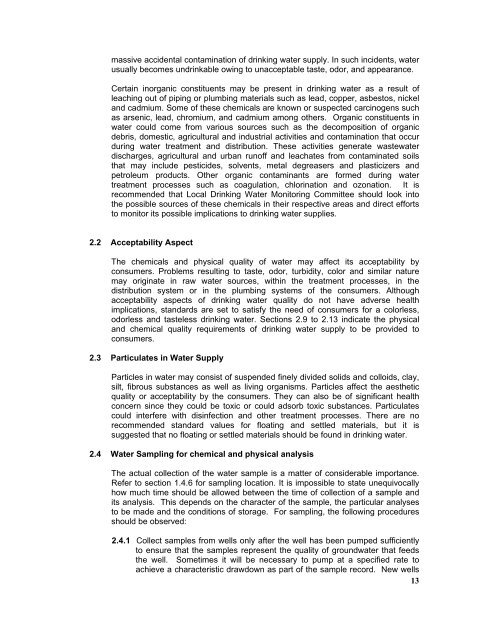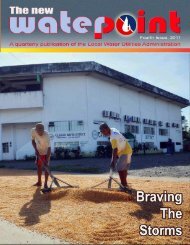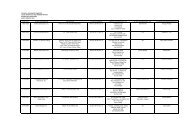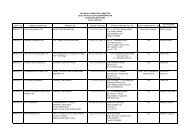Philippine National Standards for Drinking Water - LWUA
Philippine National Standards for Drinking Water - LWUA
Philippine National Standards for Drinking Water - LWUA
You also want an ePaper? Increase the reach of your titles
YUMPU automatically turns print PDFs into web optimized ePapers that Google loves.
massive accidental contamination of drinking water supply. In such incidents, water<br />
usually becomes undrinkable owing to unacceptable taste, odor, and appearance.<br />
Certain inorganic constituents may be present in drinking water as a result of<br />
leaching out of piping or plumbing materials such as lead, copper, asbestos, nickel<br />
and cadmium. Some of these chemicals are known or suspected carcinogens such<br />
as arsenic, lead, chromium, and cadmium among others. Organic constituents in<br />
water could come from various sources such as the decomposition of organic<br />
debris, domestic, agricultural and industrial activities and contamination that occur<br />
during water treatment and distribution. These activities generate wastewater<br />
discharges, agricultural and urban runoff and leachates from contaminated soils<br />
that may include pesticides, solvents, metal degreasers and plasticizers and<br />
petroleum products. Other organic contaminants are <strong>for</strong>med during water<br />
treatment processes such as coagulation, chlorination and ozonation. It is<br />
recommended that Local <strong>Drinking</strong> <strong>Water</strong> Monitoring Committee should look into<br />
the possible sources of these chemicals in their respective areas and direct ef<strong>for</strong>ts<br />
to monitor its possible implications to drinking water supplies.<br />
2.2 Acceptability Aspect<br />
The chemicals and physical quality of water may affect its acceptability by<br />
consumers. Problems resulting to taste, odor, turbidity, color and similar nature<br />
may originate in raw water sources, within the treatment processes, in the<br />
distribution system or in the plumbing systems of the consumers. Although<br />
acceptability aspects of drinking water quality do not have adverse health<br />
implications, standards are set to satisfy the need of consumers <strong>for</strong> a colorless,<br />
odorless and tasteless drinking water. Sections 2.9 to 2.13 indicate the physical<br />
and chemical quality requirements of drinking water supply to be provided to<br />
consumers.<br />
2.3 Particulates in <strong>Water</strong> Supply<br />
Particles in water may consist of suspended finely divided solids and colloids, clay,<br />
silt, fibrous substances as well as living organisms. Particles affect the aesthetic<br />
quality or acceptability by the consumers. They can also be of significant health<br />
concern since they could be toxic or could adsorb toxic substances. Particulates<br />
could interfere with disinfection and other treatment processes. There are no<br />
recommended standard values <strong>for</strong> floating and settled materials, but it is<br />
suggested that no floating or settled materials should be found in drinking water.<br />
2.4 <strong>Water</strong> Sampling <strong>for</strong> chemical and physical analysis<br />
The actual collection of the water sample is a matter of considerable importance.<br />
Refer to section 1.4.6 <strong>for</strong> sampling location. It is impossible to state unequivocally<br />
how much time should be allowed between the time of collection of a sample and<br />
its analysis. This depends on the character of the sample, the particular analyses<br />
to be made and the conditions of storage. For sampling, the following procedures<br />
should be observed:<br />
2.4.1 Collect samples from wells only after the well has been pumped sufficiently<br />
to ensure that the samples represent the quality of groundwater that feeds<br />
the well. Sometimes it will be necessary to pump at a specified rate to<br />
achieve a characteristic drawdown as part of the sample record. New wells<br />
13







